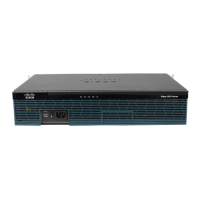248
Cisco 3900 Series, Cisco 2900 Series, and Cisco 1900 Series Integrated Services Routers Generation 2 Software Configuration Guide
Chapter Configuring the Wireless Device
Starting a Wireless Configuration Session
DETAILED STEPS
Command Purpose
Step 1
interface wlan-ap0
Example:
router(config)# interface wlan-ap0
router(config-if)#
Defines the router’s console interface to the
wireless device. It is used for communication
between the router’s Console and the wireless
device.
Always use port 0.
The following message appears:
The wlan-ap 0 interface is used for
managing the embedded AP. Please use the
service-module wlan-ap 0 session command to
console into the embedded AP.
Step 2
ip address subnet mask
Example:
router(config-if)# ip address
10.21.0.20 255.255.255.0
Example:
router(config-if)# ip unnumbered vlan1
Specifies the interface IP address and subnet
mask.
Note The IP address can be shared with the IP
address assigned to the Cisco Integrated
Services Router by using the ip
unnumbered vlan1 command.
Step 3
no shut
Example:
router(config-if)# no shut
Specifies the internal interface connection
remains open.
Step 4
interface vlan1
Example:
router(config-if)# interface vlan1
Specifies the virtual LAN interface for data
communication on the internal GE0
1
port to other
interfaces.
Step 5
ip address subnet mask
Example:
router(config-if)# ip address
10.10.0.30 255.255.255.0
Specifies the interface IP address and subnet
mask.
Step 6
exit
Example:
router(config-if)# exit
router(config)#
Exits the mode.

